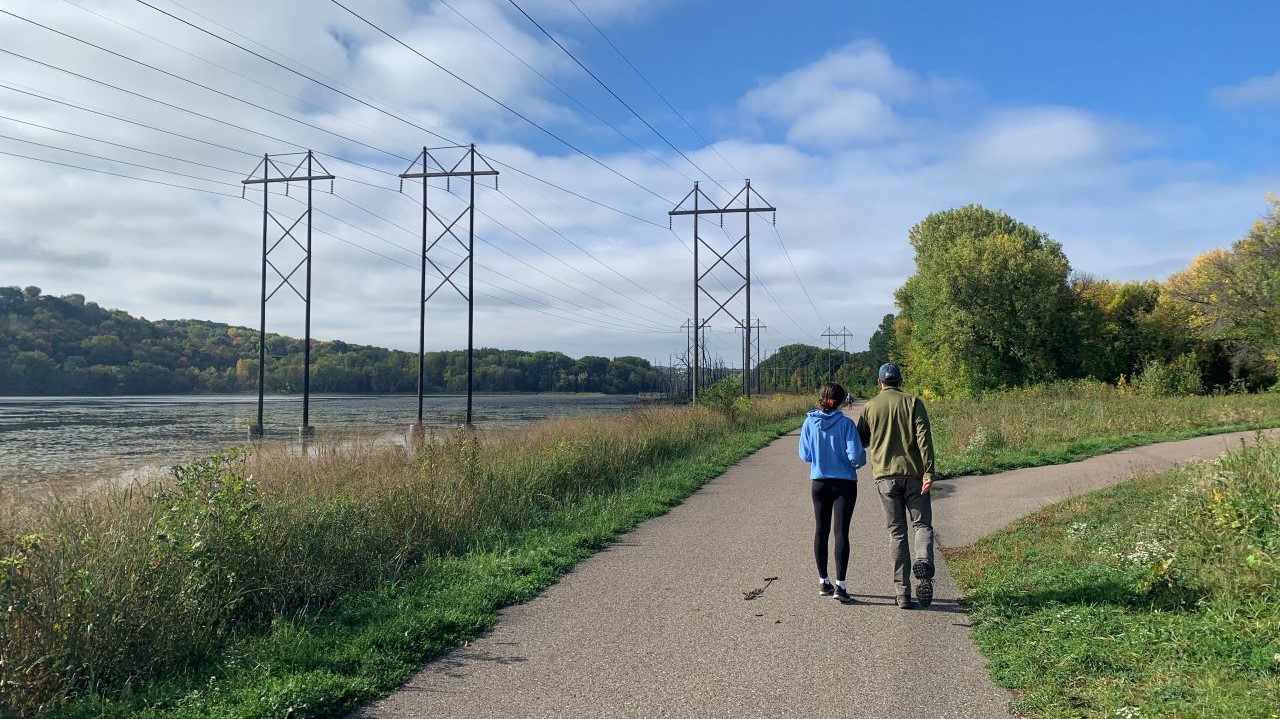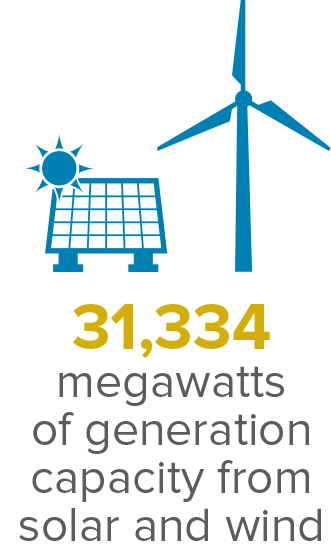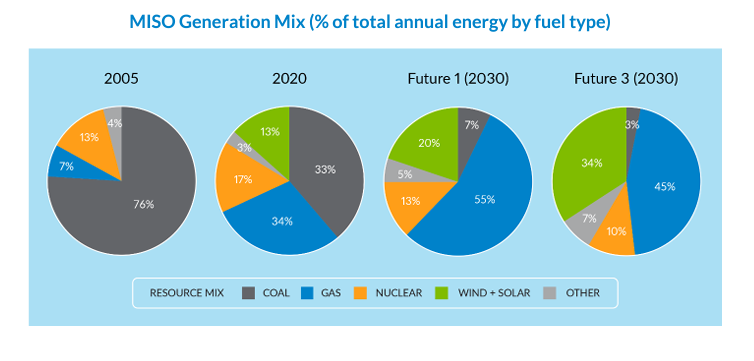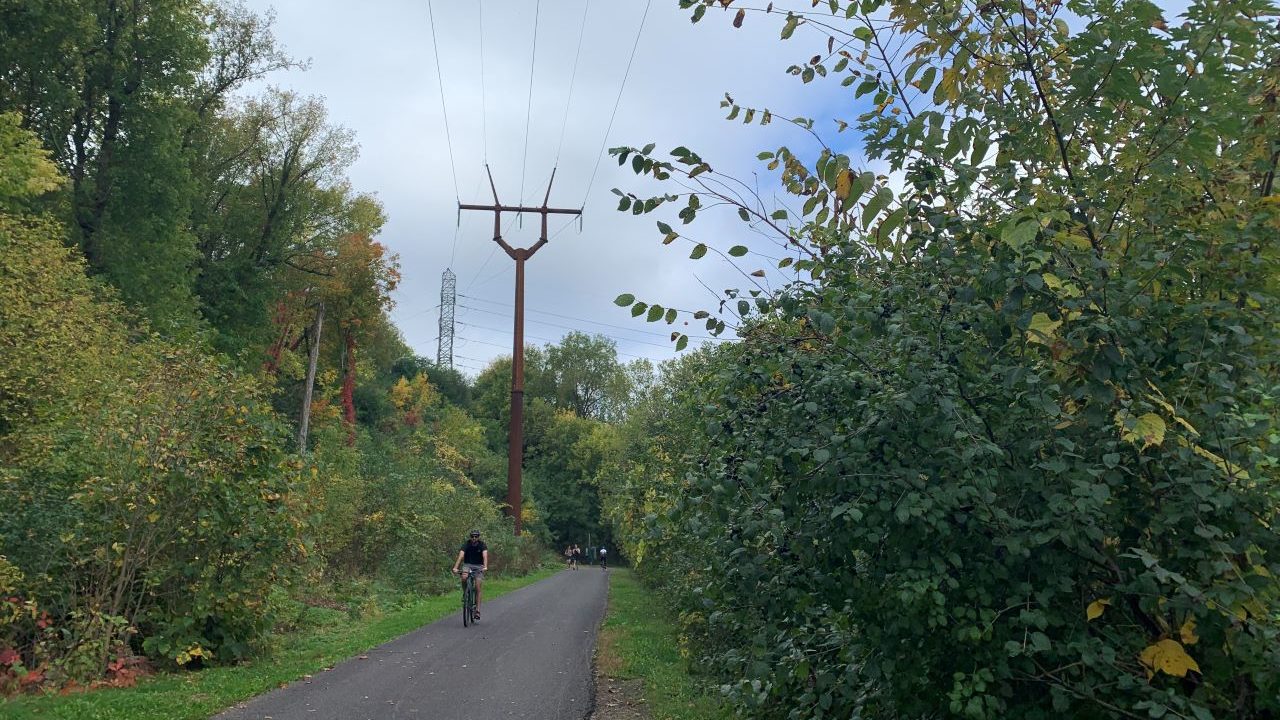MISO is vital in the effort to decarbonize our economy.

When we hear about the electric grid, it’s common to think of our local electric utility. They’re the ones we pay for our electric service after all, and it’s our utility’s trucks that we see repairing downed electricity lines. But, as explained in our “What’s up with the grid?” blog, the grid is much bigger than any single utility. It is instead a web of utilities, each interconnected with each other in a giant electric transmission and distribution system that covers the entire nation.

Beginning in the late 1990s, each of Minnesota’s utilities ceded operational control of their portion of the transmission grid to an entity called MISO, or the Midcontinent Independent System Operator, which gradually took on more responsibility over the next decade. MISO is a nonprofit organization regulated by the Federal Energy Regulatory Commission (FERC) and tasked with operating a large portion of our country’s electric grid.

Through MISO, management and operation of Minnesota’s grid is combined with that of other utilities in 14 other states, from North Dakota to Louisiana and back up to Michigan. By banding together, the utilities like ours in Minnesota that voluntarily joined MISO are better able to take advantage of economies of scale, resulting in lower electricity rates for their customers, while also diversifying energy resources, leading to greater reliability and greater resilience in the face of increasing climate risks.

But this “banding together” didn’t necessarily happen along state lines. For the most part, individual utilities were free to decide whether or not to join a grid operator like MISO, and then they sometimes had an option for which one to join. There are six other primary regional transmission operators like MISO: CAISO in California, SPP to our west, ERCOT to our South, PJM to our east, and NYISO and ISO-NE further east still. Other utilities have formed loose relationships with each other to more independently operate their respective utility territories.


As discussed in our “What’s up with the grid?” blog, MISO and other regional transmission operators are primarily responsible for organizing wholesale power markets, ensuring regional reliability, and planning new transmission lines for the electric grid of the future. While all three of these roles are equally important, it is that third planning goal where MISO can best help Minnesota and the rest of the region achieve a carbon-free economy. But this third goal does not operate in isolation. Future planning for a carbon-free grid will need to remain reliable, and market design will also be very important in helping us get there.
MISO stakeholders
As a voluntary member-based organization, MISO does not own transmission or distribution infrastructure, but is instead entrusted by the entities that own this infrastructure to reliably and efficiently manage and operate that infrastructure, aka the grid itself. As explained in “What’s up with the grid?,” this is no small task as MISO must match all electricity generation with all electricity consumption across the greater MISO grid during every moment of a given day.
However, these entities don’t just blindly hand over the keys; they want a say in how MISO goes about its business too. But MISO doesn’t just hand back the steering wheel—it takes input from a much larger cross section of interested parties, collectively called “Stakeholders.” Stakeholders can include anyone, as long as they are interested in what MISO is doing and want to help play a substantive role.
But not all Stakeholders are the same. Some Stakeholders operate businesses that directly interact with wholesale electricity markets, whereas others are primarily concerned with the indirect consequences of our electric grid, such as possible environmental or consumer implications.
Stakeholders represent a diverse set of entities, including the following:
- Private-sector utility companies, including both utilities that own transmission lines and those that don’t
- Large factories or data centers that consume large amounts of electricity
- Non-utility transmission developers
- Generators of electricity, including renewable and fossil fuel resources
- Environmental and clean energy organizations
- State regulatory authorities
- Power marketers and brokers
- Consumer advocate organizations and agencies
- Fossil fuel suppliers
As one can imagine, achieving consensus among a group as diverse as this, with competing interests across the energy landscape, is unlikely, if not plain difficult. Fortunately for MISO, Stakeholders formally only work in an advisory capacity to MISO’s Board of Directors. And, fortunately for Fresh Energy and our clean energy partners, MISO has developed a comprehensive Stakeholder process to ensure that it can make its major operational and planning decisions with as much information, and as much diversity of perspective, as possible. So, even though Stakeholders don’t run the show, their input to MISO is invaluable and ultimately helps shape the decisions that MISO staff make when it comes to our grid’s future. And at the end of the day, MISO must still ask the Federal Energy Regulatory Commission (FERC) for permission before implementing any substantive decisions it makes.
What is MISO planning for?
The world is always changing, and for the electric grid, the change we are facing today is as great a change as the grid has ever faced before. Embracing the speed of technological change, the need to replace aging infrastructure, and the growing appetite for carbon-free sources of electricity, MISO is embarking on an ambitious process to dramatically reshape the grid.
Decarbonization
We are all witnessing the decarbonization of the grid, as renewable resources such as wind and solar energy are taking a greater share of the electric grid’s footprint. However, these decarbonized forms of electricity production do not match up well with the old 20th Century grid. Wind and solar resources are usually best sited far away from where customers want to use them, and the existing transmission infrastructure near the best wind and solar sites is running out of excess transmission capacity. This means that even when the wind is blowing, without greater transmission capability, we sometimes have no choice but to turn wind turbines off. Without expanded transmission, it’s becoming more and more difficult to add new wind and solar to our grid.
At the same time, energy use is becoming more and more electrified, as homes and buildings convert away fossil gas appliances and drivers switch to electric vehicles. Electric motors are also substantially more efficient than gas-based ones, meaning that many large industrial processes are becoming electrified too. And many businesses and factories have their own decarbonization goals, meaning they’re seeking all sorts of ways to eliminate their fossil fuel and emissions activity across the board.
Taken together, decarbonization alone requires a grid that looks very different than the one we had just a generation before. But these aren’t the only factors driving MISO’s planning for the grid of the future.
Digitalization and Diversification
Better information technology and stronger computer processing power are allowing electric companies, service providers, utilities, and consumers to take advantage of market opportunities that just weren’t available before. Our homes, apartments, businesses, cars, buses, and trucks are all becoming more networked with each other and with the grid as a whole, meaning that they can increasingly interact with it. This can be by supplying additional (renewable) power into the grid, lowering power consumption when prices (and fossil fuel use) are highest, or both. Electric vehicles and battery back-up systems can work with the grid to charge when prices are lowest while supplying power to the grid when it is the most expensive. This technology is already here, and it is only getting better. But because of reliability concerns and the need for sound yet flexible market design, MISO must take a careful approach in developing processes for these types of opportunities to fully leverage the grid’s capabilities.
Demystification and Democratization
Electricity and the grid are slowly being demystified. And that will only further increase the democratization of the grid going forward. Especially as electric vehicles overtake gas-powered cars, consumers will become more comfortable with the opportunities provided by electrification and greater interaction with the grid. MISO recognizes this and is trying to ensure its markets and operations can support this trend going forward. In the next decade, consumers will have much greater control over how they interact with the grid, meaning that they’ll also have much greater control over their own respective carbon footprints.

Taken together, these five D’s of grid development (is that a sixth?) above show up in the various planning processes that MISO is currently undertaking.
The biggest planning measures happening now include:
- Transmission Planning: MISO is constantly working with Stakeholders to determine where new transmission lines are needed. In recent years, MISO embarked on the Long Range Transmission Planning (LRTP) process to determine where to place region-wide transmission lines that best take advantage of its economies of scale. This process seeks to build the transmission necessary to bring renewable energy from its more remote locations to those places where more energy is consumed. Read more about it in our past blog post on this subject.
- Generation Interconnection Planning: MISO is working both internally and with a neighboring grid operator (Southwest Power Pool) to build new transmission that will help unlock those areas with the best renewable energy resources and then bring electricity from those areas to cities and other consumers with large power needs. MISO is also working on the rules and procedures that surround the interconnection of new wind, solar, and battery facilities to find ways to increase efficiencies, expand opportunities, and lower costs.
- Distributed Energy Resources Planning: MISO is developing new rules and processes that will allow consumers, smaller power producers, and hybrid renewable energy resources to better take advantage of new opportunities to participate in the grid. This includes things like developing processes for businesses to aggregate various renewable and digital energy solutions that occur at the micro level, and it also includes working with solar, wind, and battery hybrid operations that want to fully leverage the advantages of their resources in wholesale electricity markets.
- Resource Adequacy: As part of its reliability mission, MISO must ensure that it has enough electric resources to draw upon in the most difficult conditions imaginable. MISO is currently taking a new look at how it determines the best method to ensure that it has enough resources to draw from during all seasons in the year so that MISO and utilities may more effectively plan for future needs.
- Grid Enhancing Technology: MISO can further increase its transmission capacity by increasing the volume and precision of its transmission monitoring systems. Current transmission capacity ratings are based on worst-case weather conditions, but with new technology, MISO can turn these fixed ratings into dynamic ones that will permit more electric power transmission during most of their operating lifespan.
- Evolution of Market Systems: To best leverage all the changes that are occurring within MISO’s operation of the grid, it must match those opportunities with market systems that permit their most efficient use possible. Not only does this include new rules and processes for many of the items above, but it also includes the development of new information-gathering and forecasting systems.
Why MISO?
Why not just go it alone, like Texas? Because MISO brings a host of economies of scale with it. That’s why engaging with MISO decision-making processes and advocating for Minnesotans is a priority for Fresh Energy’s Clean Electricity team. By joining MISO, Minnesota may take advantage of those states that have better renewable resources. Otherwise, in order to meet its decarbonization goals, Minnesota would need to rely more on its own wind and solar resources, most of which would be less efficient than wind and solar resources in other states.

Furthermore, by being a member of MISO, Minnesota utilities and their customers can take advantage of the market efficiencies inherent in participating in MISO’s many wholesale markets. Without access to MISO’s energy markets, Minnesota would be paying a premium for renewable energy and other grid services from neighboring states.
Finally, reliability is perhaps the biggest, most salient reason for being a member of MISO. While Minnesota is far more interconnected with its neighbors than Texas, being a member of MISO helps ensure that Minnesota will only be more interconnected to the rest of the country than it otherwise would. This means that, if and when disaster strikes, Minnesota will be in a better position to weather the storm. And when the wind isn’t blowing and the sun isn’t shining over Minnesota, it likely is somewhere else over MISO’s footprint, and Minnesota utilities can more easily draw from those far-away resources to bring affordable, clean electricity to our state.
Taken together, annual benefits to MISO members average $3.4 billion each year, and that savings is passed on to consumers. Furthermore, that savings is a conservative measure as it doesn’t capture all the benefits that aren’t quantifiable, such as positive health impacts, reduced climate risk, and increased resiliency. Fresh Energy looks forward to continuing its engagement with MISO and all relevant stakeholders to speed the transition to a zero-carbon electric grid, optimizing generation, transmission, and distribution through clean energy deployment and innovation.
Still have questions about MISO and the grid? Listen to Mike talk through MISO and the grid in this episode of Decarbonize: The Clean Energy Podcast.

